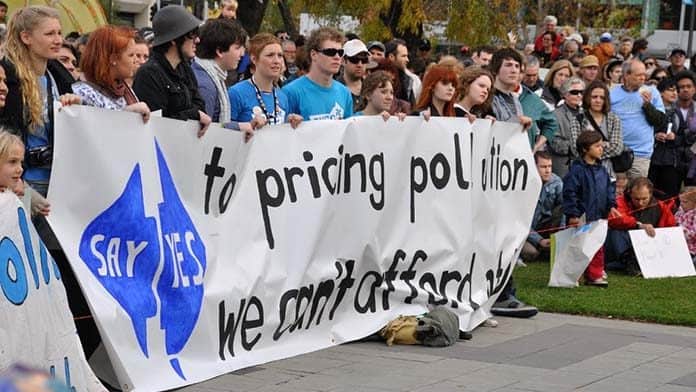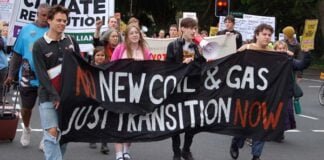A large grassroots climate movement emerged from 2008—but the decision to defend the carbon tax sent it into decline, writes Chris Breen
The global student climate strikes have put climate change back on the agenda and seen a rebirth of the climate movement.
Climate change is already having an impact. If we pass crucial tipping points abrupt climate change will lead to severe agricultural disruption, political turmoil and potentially millions of climate refugees.
Urgent action is needed.
But the reborn climate movement must learn the lessons of the recent past if it is to avoid the mistakes that led to the movement’s collapse in 2011-12. We need to harness sharp clear demands to social forces with the power to bring change.
In early 2008 the Climate Emergency Network was formed in Melbourne, based on some of the ideas in the book Climate Code Red by David Spratt and Phillip Sutton.
At its peak it was made up of 30 active local groups and had general meetings of up to 200 people. It called rallies of 5000, and promoted the Walk Against Warmings called by large environmental NGOs.
There were a series of national grassroots Climate Action Summits that drew between 300 and 500 activists.
But the movement was quickly confronted by the power of big business and the fossil fuel corporations to block serious action.
The first Walk Against Warming in November 2007 mobilised 50,000 people in Melbourne, and 100,000 nationally. The rally added to the momentum to elect the Rudd Labor government two weeks later, but it only demanded vague “Climate Action”.
Rudd said that, “Climate Change is the great moral challenge of our generation”. But his response, the Carbon Pollution Reduction Scheme (CPRS), was designed to be acceptable to big business.
This meant adopting a market mechanism with a pathetic 5-15 per cent reduction target, free permits for polluters and unlimited offsets. Modelling showed it would actually increase emissions. The Greens rightly voted against it, condemning it as “worse than useless”.
The climate movement campaigned for a stronger policy, only to see Kevin Rudd offer even greater handouts to polluting companies in the hope of securing Liberal Party and corporate support.
Then Labor abandoned the scheme, and any climate action policy with it. Rudd lost a million votes in a fortnight and was removed as leader shortly afterwards.
However the movement was far from clear on what kind of action was needed, and what demands to raise as an alternative.
Carbon tax
The carbon tax introduced by Labor and The Greens in 2011 was, tragically, supported by large sections of the movement, particularly by the big environmental NGOs, GetUp and The Greens, who organised “Say Yes” rallies in 2011.
It aimed to force companies and consumers to reduce emissions through putting a price on carbon emissions. Despite talk of making the polluters pay, the carbon tax was designed so that companies would pass the cost on through increasing electricity prices, as then Prime Minister Julia Gillard openly admitted.
This was a gift to Tony Abbott and the Liberals, who declared that the tax would raise power prices and damage workers’ cost of living, promising to axe it.
Sections of the movement, like the Climate Emergency Network and Friends of the Earth, were sceptical about the tax, but remained isolated.
As a result, by late 2011, the Climate Emergency Network and the climate movement around it had begun to decline.
As Solidarity wrote at the time, “A carbon tax was no way to win popular support for action on climate change. An Essential poll after the [2010] election found 47 per cent oppose it with only 39 per cent in support.
“Worse still, the carbon tax would never have substantially increased the use of renewable energy or reduced emissions. Treasury modelling released by the government showed Australia’s emissions would continue to rise until 2030. Labor’s claimed ‘reduction target’ of 5 per cent by 2020 was only met through buying overseas and domestic offsets, which were to make up at least half of the emissions ‘cuts’.”
The carbon tax painted climate action as linked to lower living standards. This meant the climate movement’s support for the tax cut it off from wider layers of workers. The movement became even more restricted to middle class supporters unconcerned by the prospect of rising prices.
Enthusiasm for action on climate change dropped as a result. In 2006 the annual Lowy Poll showed 68 per cent viewed climate change as a “serious and pressing problem” requiring action. But this was down to just 40 per cent in 2013.
All the movement’s efforts to build support for the carbon tax went nowhere.
Tony Abbott and the Coalition won the 2013 election in large part on a promise to scrap the carbon tax, and it was repealed in 2014.
Adani, coal and jobs
There are important lessons for the climate movement from the carbon tax debacle. Similar questions over winning workers to the climate movement have surfaced around the politics of Adani, coal and jobs.
This was reinforced by May’s federal election result. Labor equivocated on Adani, suggesting it might stop the mine, while failing to provide a credible plan for alternative jobs. It suffered at the polls in Queensland regions hit hard by unemployment and economic insecurity.
Coal workers and miners in Queensland and the Hunter Valley rightly fear being left behind should the industry close.
The question of jobs doesn’t just affect those in coal regions, but is an obstacle to winning the active support of the wider union movement. One of the arguments run by Australian Education Union officials in Victoria against actively calling on teachers to join the last climate strike was that the CFMMEU did not support the demand to stop Adani.
A climate movement that actively fights for jobs could begin to turn this around. Former coal workers in South Australia fought for the Port Augusta Solar Tower project in the wake of the closure of the coal-fired power station there.
The project won a tender to supply electricity to the state, but collapsed in April due to lack of finance.
This was a perfect opportunity for the climate movement to step in and fight for government to build the project, which could have been a win for renewables and jobs. If a “just transition” is to be more than just a slogan it has to be fought for.
To win the active participation of workers, climate action must be linked to improved living standards. Winning those in the fossil fuel industry and beyond will require fighting for job guarantees with union conditions and pay.
The narrow focus of the climate movement on Adani, without any fight for jobs, is an obstacle to building this support.
Winning working class support is also vital to mobilising the power to force radical change.
To make the shift away from fossil fuels on the scale we need requires overcoming powerful business interests in an economy powered by fossil fuels. We need a mass movement powerful enough to impose its will on governments and corporations unwilling to act.
Workers are the only group in society with both the interest and the power to force such action on climate change—through strike action they can paralyse the entire economy and shut off corporate profits.
After losing his seat on election night, Tony Abbott said, “Where climate change is a moral issue, we Liberals do it tough, but where climate change is an economic issue, as the result tonight shows, we do very, very well.”
To beat the Liberals over climate, the movement needs to win on the economics as well as the urgent need to act.
That means fighting against privatisation and market mechanisms. It means demanding that government directly fund the renewable and public transport transition we need, and directly employ the hundreds of thousands needed to do it, because the market cannot and will not do the job.
We don’t need more market schemes or taxes. We know what needs to be done to decarbonise the economy and should demand it directly.
The 20 September climate strikes can be an important stepping up of climate action.
The demands of previous school strikes were: Stop the Adani coal mine; No new coal, oil and gas projects; 100 per cent renewable energy by 2030.
Demanding 100 per cent renewable energy is a stronger pro-jobs demand than Stop Adani, and crucially focuses on the transition needed within the Australian economy rather than exports.
The only way to get 100 per cent renewable energy by 2030 is for government to directly fund and build it, like they once built all the coal-fired power stations in Australia. Demands for 100 per cent publicly owned renewables by 2030 and climate jobs could win wide support amongst workers.
Extinction Rebellion, which started in the UK and has come to Australia, is another positive development. It is demanding governments tell the truth about climate change, reduce emissions to net zero by 2025 and call a citizens’ assembly.
This would postpone the decisions about how to cut emissions to a citizens’ assembly.
But the climate movement can’t avoid taking a position on government policies that are counter-productive or don’t go far enough.
Canada for instance declared a Climate Emergency on 18 June this year and the very next day approved the expansion of a pipeline to carry 600,000 barrels of oil per day.
The climate movement must fight alongside unions for jobs, and reject market-based solutions like carbon trading or carbon taxes.
Any concession to the idea that climate action means attacks on working class living standards will only bring setbacks.






